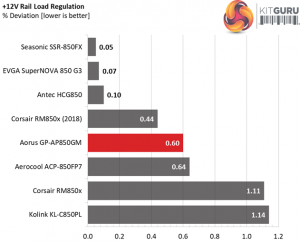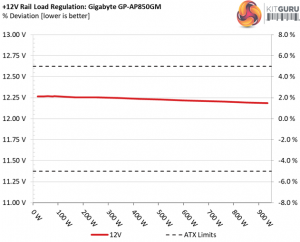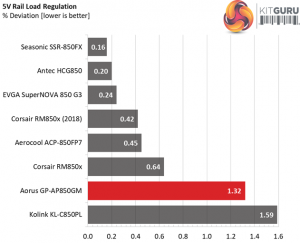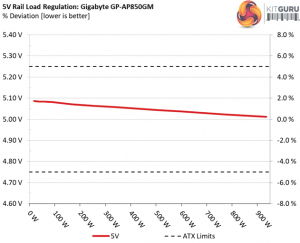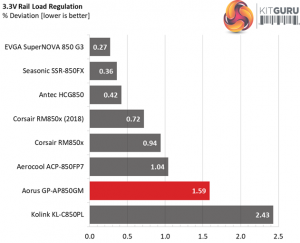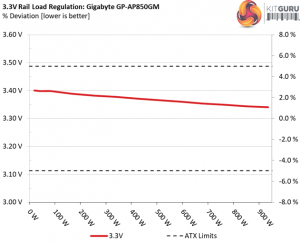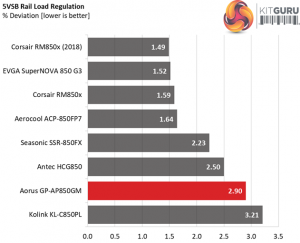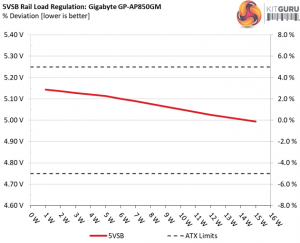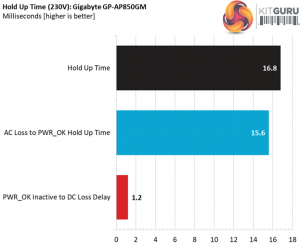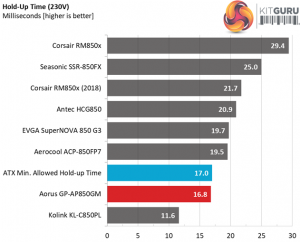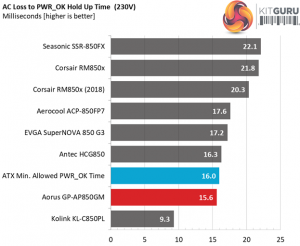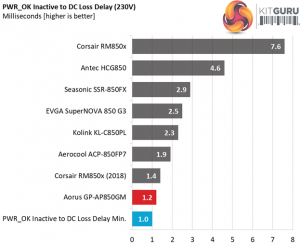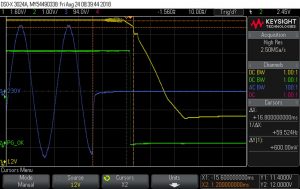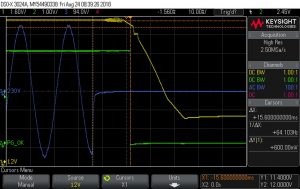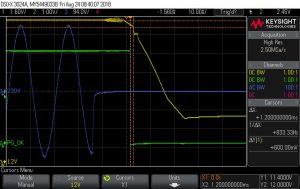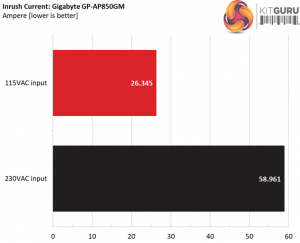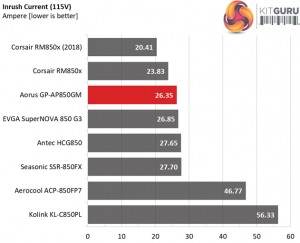To learn more about our PSU tests and methodology, please check out How We Test Power Supply Units.
Primary Rails And 5VSB Load Regulation
Load Regulation testing is detailed here.
Hold-Up Time
Our hold-up time tests are described in detail here.
The oscilloscope screenshots that we took during the hold-up time measurements:
The hold-up time is only a hair away from what the ATX spec requires (17ms) and the power ok signal is close as well to 16ms.
Inrush Current
For details on our inrush current testing, please click here.
The inrush current is low with 115V and a little higher than the normal with 230V.
Load Regulation And Efficiency Measurements
The first set of tests reveals the stability of the voltage rails and the GP-AP850GM’s efficiency. The applied load equals (approximately) 10 to 110 percent of the power supplies maximum load in increments of 10 percentage points.
We conducted two additional tests.
During the first, we stressed the two minor rails (5V and 3.3V) with a high load, while the load at +12V was only 0.1A. This test reveals whether a power supply is compatible with Intel’s C6/C7 sleep states or not. In the second test, we determined the maximum load the +12V rail could handle with minimal load on the minor rails.
| Test # | 12V | 5V | 3.3V | 5VSB | DC/AC (Watts) | Efficiency | Fan Speed (RPM) | PSU Noise (dB[A]) | Temps (In/Out) | PF/AC Volts |
| 1 | 5.159A | 1.968A | 1.942A | 0.978A | 84.888 | 85.923% | 0 | <6.0 | 46.65°C | 0.963 |
| 12.267V | 5.083V | 3.398V | 5.114V | 98.796 | 40.33°C | 115.12V | ||||
| 2 | 11.298A | 2.959A | 2.920A | 1.176A | 169.342 | 89.404% | 532 | 14.2 | 40.77°C | 0.983 |
| 12.254V | 5.071V | 3.388V | 5.101V | 189.413 | 49.04°C | 115.11V | ||||
| 3 | 17.828A | 3.455A | 3.399A | 1.376A | 254.476 | 90.768% | 590 | 17.0 | 41.18°C | 0.989 |
| 12.255V | 5.064V | 3.382V | 5.089V | 280.358 | 51.70°C | 115.11V | ||||
| 4 | 24.374A | 3.955A | 3.907A | 1.576A | 339.688 | 91.208% | 765 | 24.2 | 41.91°C | 0.987 |
| 12.246V | 5.058V | 3.378V | 5.077V | 372.432 | 53.10°C | 115.11V | ||||
| 5 | 30.606A | 4.948A | 4.894A | 1.777A | 425.015 | 90.992% | 860 | 27.9 | 42.12°C | 0.986 |
| 12.237V | 5.051V | 3.371V | 5.064V | 467.092 | 54.28°C | 115.35V | ||||
| 6 | 36.778A | 5.950A | 5.883A | 1.980A | 509.536 | 90.642% | 1075 | 33.7 | 42.67°C | 0.988 |
| 12.228V | 5.044V | 3.366V | 5.051V | 562.141 | 55.19°C | 115.11V | ||||
| 7 | 43.028A | 6.950A | 6.876A | 2.184A | 594.873 | 90.139% | 1255 | 37.8 | 43.30°C | 0.989 |
| 12.219V | 5.037V | 3.360V | 5.038V | 659.951 | 56.06°C | 115.10V | ||||
| 8 | 49.284A | 7.954A | 7.871A | 2.388A | 680.216 | 89.520% | 1480 | 42.2 | 43.63°C | 0.990 |
| 12.211V | 5.030V | 3.354V | 5.025V | 759.846 | 57.20°C | 115.11V | ||||
| 9 | 55.946A | 8.463A | 8.360A | 2.391A | 765.160 | 88.976% | 1630 | 43.7 | 44.61°C | 0.991 |
| 12.202V | 5.023V | 3.349V | 5.019V | 859.963 | 58.82°C | 115.09V | ||||
| 10 | 62.349A | 8.972A | 8.884A | 3.004A | 850.007 | 88.249% | 1760 | 45.5 | 45.70°C | 0.992 |
| 12.194V | 5.017V | 3.344V | 4.994V | 963.187 | 60.22°C | 115.11V | ||||
| 11 | 69.346A | 8.981A | 8.893A | 3.008A | 934.773 | 87.580% | 1830 | 46.5 | 46.34°C | 0.992 |
| 12.186V | 5.012V | 3.340V | 4.989V | 1067.342 | 61.74°C | 115.09V | ||||
| CL1 | 0.151A | 14.002A | 13.999A | 0.000A | 120.115 | 84.501% | 0 | <6.0 | 46.79°C | 0.977 |
| 12.260V | 5.065V | 3.382V | 5.125V | 142.146 | 42.00°C | 115.16V | ||||
| CL2 | 70.522A | 1.002A | 1.001A | 1.000A | 873.623 | 88.531% | 1780 | 45.8 | 45.64°C | 0.992 |
| 12.197V | 5.030V | 3.356V | 5.067V | 986.802 | 60.32°C | 115.09V |
The load regulation at +12V is tight enough, while on the 5V and 3.3V rails stays within 2%. At 5VSB is at 2.9% so it could use some more tuning, although load regulation on this rail isn't of great importance. In the efficiency section, the PSU easily meets the 80 PLUS Gold requirements, although we test at a much higher ambient than the 80 PLUS organisation, where efficiency takes a big hit.
The fan profile is not aggressive, but not super relaxed either. The output noise breaks the 40 dB(A) mark during test #8 and in the overload test the fan makes its presence well felt at 46.5 dB(A). Finally, the semi-passive mode is only active during the two light load tests (test #1 and CL1).
 KitGuru KitGuru.net – Tech News | Hardware News | Hardware Reviews | IOS | Mobile | Gaming | Graphics Cards
KitGuru KitGuru.net – Tech News | Hardware News | Hardware Reviews | IOS | Mobile | Gaming | Graphics Cards


